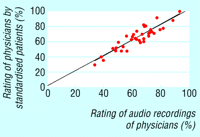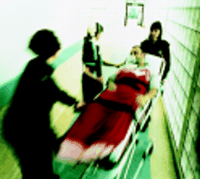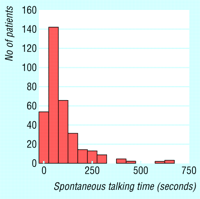This week in the BMJ
Volume 325, Number 7366, Issue of 28 Sep 2002Standardised patients are a valid measure of quality of care
Role models can help make good doctors
Measuring goodness in individuals and systems
Two minutes of talking is enough for most patients
Patients ration consultation time
How to acquire communication skills
The problem with competency based medical training
What's a good doctor?
Reviews give further views
Standardised patients are a valid measure of quality of care
Assessments that use standardised patients are valid for measuring the
quality of physicians' care in a variety of common medical conditions.
Luck and Peabody (p 679) compared the assessments of standardised
patients of 40 consultations with an independent assessment of the
consultations based on audio recordings; overall agreement was 91%.
They conclude that these results may justify using standardised
patients as a "gold standard" in comparing quality of care across
sites or in evaluating data obtained from computerised clinical
vignettes.

Role models can help make good doctors
Students identify compassion, openness, integrity, and good
relationships with patients as attributes they seek in their role models. Yet some senior doctors show poor attitudes and unethical behaviour that causes confusion and distress in doctors under their
supervision. Paice and colleagues (p 707) discuss whether role models
can still be an effective means of imparting professional values,
attitudes, and behaviours in a health service that is increasingly
sensitive to society's expectations.
Measuring goodness in individuals and systems
The traditional qualitative, anecdotal approach to measuring
"goodness" is increasingly being replaced by data on effectiveness, safety, acceptability, and efficiency. Patients, funders,
commissioners, provider organisations, and heathcare professionals want
to know how "good" individual doctors and teams are. Pringle and
colleagues (p 704) outline the systems currently in place for assessing
goodness. The authors say that measures of quality of care need to be
appropriate to the task and that during creation of this data the staff
should not be demoralised or demotivated.

(Credit: TIM BEDDON/SPL)
Two minutes of talking is enough for most patients
Doctors do not risk being swamped by their patients' complaints if
they listen until a patient indicates that his or her list of
complaints is complete. In a study by Langewitz and colleagues (p
682) doctors activated a stopwatch at the start of communication and
stopped it when patients indicated they wanted the doctors to take the
lead. The authors say that two minutes of listening will be sufficient
with nearly 80% of patients.

Patients ration consultation time
Patients feel an intense sense of time pressure and impose their own
rationing on the length of consultations. A qualitative study by
Pollock and Grime (p 687) of 32 general practice patients with mild to
moderate depression and 30 respondents from the Depression Alliance
also found a mismatch between patients' sense of time entitlement and
the doctor's capacity to offer more time. Mechanic comments (p 690)
that good doctors let their patients disclose their problems and make
extra time when possible.

How to acquire communication skills
Good doctors communicate effectively with patients they identify
patients' problems more accurately, and patients are more satisfied
with the care they receive. Doctors with these skills also have greater
job satisfaction and less work stress. Maguire and Pitceathly (p 697)
review the key tasks in communication and the skills needed and
describe how to acquire them.
they identify
patients' problems more accurately, and patients are more satisfied
with the care they receive. Doctors with these skills also have greater
job satisfaction and less work stress. Maguire and Pitceathly (p 697)
review the key tasks in communication and the skills needed and
describe how to acquire them.

(Credit: ALFRED PASIEKA/SPL)
The problem with competency based medical training
The competency based approach to undergraduate and postgraduate medical
training consists of analysing occupational roles, translating these
roles into outcomes, and assessing trainees on the basis of the
performance of these outcomes. Leung (p 693) explores the origins and
the development of the approach and evaluates its current role in
medical training, warning that it should not be introduced universally.
Diwaker (p 695) writes that Leung's misgivings about competency based
education represent one end of a spectrum of views.
What's a good doctor?
Over 100 people from 24 countries submitted rapid responses to our web
based debate on what a good doctor is and how one is made. We have
selected 14 and summarise the rest. Everyone had something different to
say, writes Tonks (p 715). For some, the notion of a good doctor was
simple: it was one who satisfies patients or whom you would trust
yourself. For others, defining a good doctor was more difficult.
Like describing a good car or a good play, it all depends on the
perspective. Patients, for example, wanted good listeners, and
educators wanted good teachers.

Reviews give further views
In this week's reviews section, Guardian columnist Polly
Toynbee (p 718) asks whether the new edition of Tomorrow's
Doctors is an idealistic or practical standard to be set for new
doctors. Comedian and writer Arthur Smith (p 723) gives us his 15 rules for doctors, which were formulated from his recent experience as a
patient; they include: "Make sure that no one dies and everyone gets
better." Psychoanalyst Jeremy Holmes (p 722) writes that the search
for the good doctor is an illusion and that we should learn to bring
our good and bad parts together to become a "good enough" doctor.